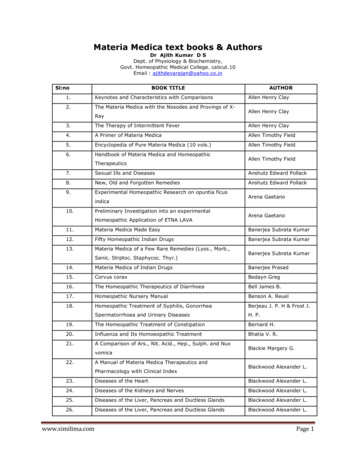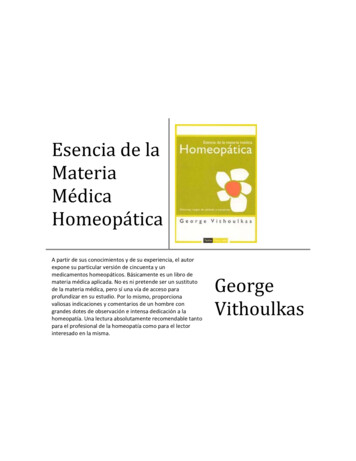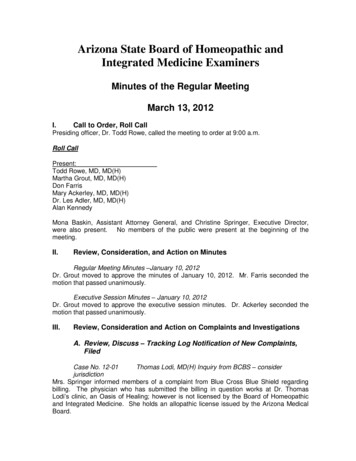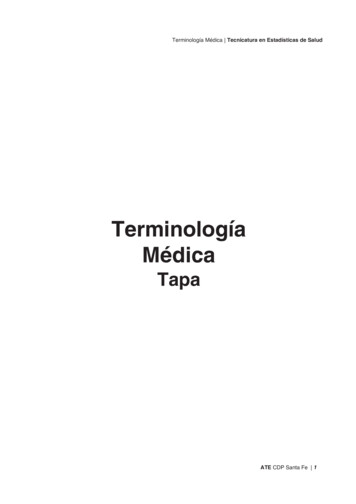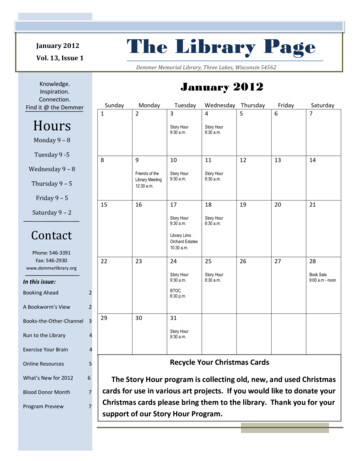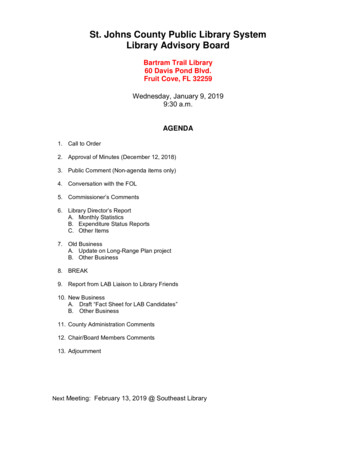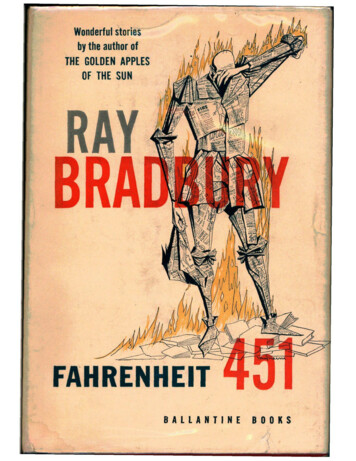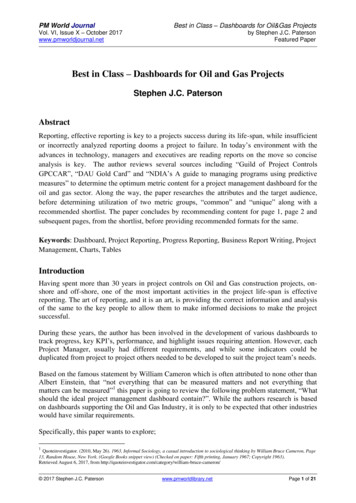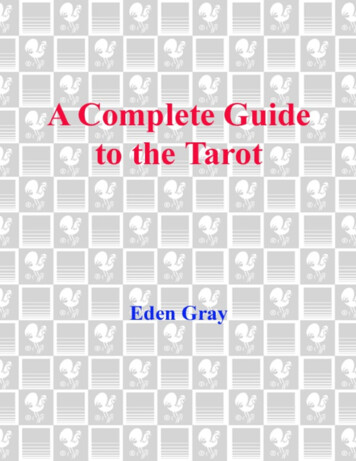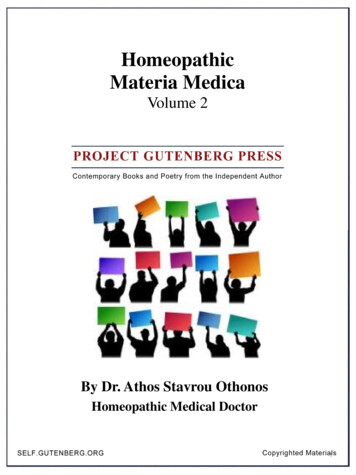
Transcription
HomeopathicMateria MedicaVolume 2By Dr. Athos Stavrou OthonosHomeopathic Medical Doctor
1HOMEOPATHICMATERIA MEDICAVOLUME 2(Sulphur, Argentum Nitricum, Gelsemium, Thuja,Valeriana, Platina, Phosphor)DescriptionofHuman IdiosyncrasiesAthos OthonosHomeopathic Medical Doctor
2CONTENTSABOUT THE STRUCTURE OF THIS BOOKPREFACECHAPTER 1: SULPHURA.IDIOSYNCRATIC DIAGRAM1.1 Psoric and Sycotic Sulphur1.2 The pessimist, superficial, unconventional philosopher1.3 Comparison between psoric Sulphur and Lycopodium1.4 The effect of Idiosyncrasy on Secondary Behavior1.5 Superficial erudition1.6 Superficial, pessimistic philosophical tendency1.7 Psoric introversion and isolation1.8 Laziness and boredom1.9 Sycotic Sulphur1.10 Hot, greasy, dirty and slovenly1.11 The idiosyncratic diagram of SulphurB.LECTURE1.12 Hot and sweating1.13 Redness, acrid sweat, offensiveness1.14 The “dirty, ragged, shallow philosopher”1.15 Slovenly1.16 Boredom or over-activity1.17 Stooped and slender or greedy fat1.18 Psoric “Buddha” or sycotic gale!1.19 Introvert; living in the world of his own1.20 Shallow philosopher1.21 Crude practical joker1.22 Neglectful as to his health and indifferent as to little everydaymatters1.23 The superficial bibliomaniac of the strange and mystery books
3CHAPTER 2: ARGENTUM NITRICUM, GELSEMIUM, THUJAA.ARGENTUM NITRICUMA.IDIOSYNCRATIC DIAGRAM2.1 Constant flow of ideas with inadequate filtering2.2 Obsessive ideas in the form of “What if ?”2.3 Obsessive Behavior2.4 Idiosyncratic Diagram of Argentum NitricumB.LECTURE2.5 General physical characteristics similar to Sulphur2.6 Desire sweets grade 32.7 Obsessive ideas and Compulsive Behavior2.8 Obsessive fear of heights and fear of insanity2.9 “What if ?”2.10 Compulsive movements, nervous tics, germ-phobia2.11 Anxiety while waiting2.12 Obsessive fear about his healthB.GELSEMIUM2.13 Timidity and stage fright2.14 Nervous symptoms after embarrassment2.15 Not capable of handling usual situationsC.THUJA2.16 Sycotic physical predispositions
42.17 Greasy skin, offensive sweat, persisting acne2.18 Groundless Lack of Self confidence2.19 Unfounded Guilt2.20 Fear of heights and feeling as if being judged all the time2.21 IntroversionCHAPTER 3: VALERIANAA.IDIOSYNCRATIC DIAGRAM3.1 The modern, reactive, spoiled, insecure teenager/young woman3.2 Insecure-Aggressive3.3 So thirsty for attention and love but still so reactionary3.4 Tendency for exclusiveness and jealousy3.5 Very ambitious and “unconventional”3.6 Coward-Aggressive behavior3.7 Nervous, restless and touchy3.8 Introversion and indirect behavior3.9 Mistrustful and temperamental3.10 Idiosyncratic Picture of ValerianaB.LECTURE3.11 Nervous and mistrustful woman3.12 “Thoroughly Slovenly Appearance”3.13 Fake unconventional3.14 Ironical and touchy
53.15 Reactionary and insecure3.16 Faking the “cultured” woman3.17 She “castrates” her husband but then she can’t be pleased by him3.18 Male/female nature as to sexuality3.19 The great value of the knowledge of human idiosyncrasies3.20 Wayward in sex and love3.21 All idiosyncratic characteristics are but imbalances!3.22 You just can’t fool Universal Laws!3.23 Reactionary and temperamental3.24 Her behavior doesn’t make any sense!3.25 A spoiled, immature girl3.26 Mistrustful and jealous3.27 Revengeful, wants to get even, to get on top3.28 She bears a grudge3.29 Introvert; pity makes her angry3.30 Nervous headaches and other nervous symptoms3.31 Fear of being raped and fear of male violence3.32 Ambitious and often setting up things for her3.33 Restless and nervous; abuse of coffee and tobaccoCHAPTER 4: PLATINAA.IDIOSYNCRATIC DIAGRAM4.1 The syphilitic vanity of the “First One”4.2 Vanity in the physical field
64.3 Fan of high life!4.4 Air/Sense of superiority4.5 Her motto: “Success is happiness!”4.6 Strong, tough, egoistic, ambitious person4.7 Psoric and sycotic version of Platina4.8 A self-centered “Queen”4.9 Dominant, demanding and irritable4.10 Male Platina4.11 Idiosyncratic Diagram of PlatinaB. LECTURE4.12 “She is beautiful and she knows it!”4.13 The “Queen”4.14 “As if taller”4.15 Snobbish4.16 Rigid4.17 The blonde “bimbo” or the smart “goddess”4.18 Anything for the palace!4.19 Her sole goal is to be the first one!4.20 Dread of wrinkles and ugliness4.21 Nymphomania4.22 Dominance and vanity instead of multilevel orgasm
7CHAPTER 5: PHOSPHORA.IDIOSYNCRATIC DIAGRAM5.1 Psoric altruism with lack of moderation and differentiation5.2 Very social, pleasure seeker and cooperative5.3 Extrovert and irascible5.4 How his psoric altruism causes the collapse of his AutonomicNervous System5.5 The typical likeable hypochondriac5.6 A Nature lover5.7 Idiosyncratic Diagram of PhosphorB.LECTURE5.8 Introduction5.9 Phases A, B, C and D regarding balance5.10 The vivid, smart, compassionate, “good kid”5.11 Extremely social and likeable5.12 Like a gale when angry5.13 Pure, innocent, idealist and fighter5.14 Sensitive and compassionate5.15 The perfect victim of syphilitic people!5.16 A great, sensitive, open yet gullible heart5.17 Not a single idiosyncratic tendency/behavior is a result of freechoice5.18 Projected image/secondary behavior is one thing and primarybehavior is another
85.19 Extremely dutiful5.20 Clever and vivid5.21 A special interest for health matters at phase A5.22 Tendency for ice-cold water5.23 Phase B: Neurovegetative symptoms5.24 The vicious circle of Neurovegetative Symptoms5.25 Tests, doctors, again tests and more doctors!5.26 Likeable and grateful5.27 Thirsty for consolation and support5.28 Fond of Sports and Nature5.29 Extremely extrovert and social5.30 Mostly afraid of symptoms per se and not so much afraid of thedisease or death5.31 Differential Diagnosis from other neurovegetative idiosyncrasies5.32 Phase C: withdrawal5.33 The sensitive, hot lover!
9ABOUT THE STRUCTUREOFTHIS BOOKThis Homeopathic Materia Medica was based on material from twodifferent phases of my clinical practice.The first material concerns the hierarchical description of thirteen basicidiosyncrasies according to a certain scheme. This scheme is notaccidental. It is in agreement with Miasmatic IdiosyncraticHomeopathy and can be called Hierarchical Miasmatic IdiosyncraticScheme. It follows the hierarchical line: Miasmas, Primary/BasicPassions, Thinking, Emotions and Behavior. For full understanding of theterms used and their significance one must refer to my other books thatdeal with relevant subjects.The second material originates from lectures on Homeopathic MateriaMedica that I gave to doctors some years afterwards. The aim of theselectures was to pass to the trainees the “main idea”, the “essence” ofevery idiosyncrasy, focusing on how an idiosyncrasy is presented to thedoctor in every day clinical practice. During these lectures I speak free,by memory, without any notes on hand because my concern is not tomake a full and thorough “academic” presentation but rather to give anunderstandable live picture of the idiosyncrasy. A picture that can beeasily assimilated and stay permanently inside the mind and heart of thetrainee.At first, I thought of “compressing” these two different descriptions inone. But, on second thought, I decided to lay both so as to enable thereader to see the same thing from two different, yet useful, aspects.During this layout you will see that some things are said twice, but from
10my experience, that is also useful because it stresses the maincharacteristics of an idiosyncrasy.Anything that is said about an idiosyncrasy is only, I repeat only, what Ihave confirmed and reconfirmed in clinical practice the last 25 years. Ideliberately omit any bibliographical information that was not confirmedin my practice even if it was said by great teachers of Homeopathy. Weshould not forget that James Tyler Kent, one of these great masters, hassaid that “There are no authorities in Medicine, only laws and principles”.I also deliberately omitted specific physical symptoms and emphasized ongeneral physical symptoms and mainly on psychological symptoms inrespect to the Law of Hierarchy, because these are the most important inMiasmatic Idiosyncratic Homeopathy that I teach and practice. Thelanguage used is at times scientific and other times plain because frommy point of view, homeopathic case taking is a live every day Scienceand Art.
11PREFACEWhenever we refer to Homeopathic Materia Medica it is of extremeimportance to bear in mind that there are several different kinds ofMateria Medica. The use and usefulness of each one varies a lot. In fact,the kind of Homeopathy you practice depends on the kind of MateriaMedica you study and use! Let me remind you an important rule: Resultsdepend on the means you employ and on how you employ it. Our wholehomeopathic practice and thus therapeutic results, depend on our meansdata (Materia Medica) and on how we employ it (laws and skill).The first Materia Medica used were those that registered in detail all thesymptoms produced during the “Provings” of raw materials on healthypeople, i.e. the Proving of Lycopodium. We could call these books asMateria Medica of Provings.Then we had that Materia Medica that gathered together Provings of thesame raw material conducted by different researchers, at different timeson different people. The aim was to compare the similarities anddifferences of the experimental data. These could be called ComparativeMateria Medica of Provings.As time passed, another kind of Materia Medica appeared: the ones thatfocus on the pathogenesis of the illnesses; on the abnormal mechanismsthat derange normal physiology and produce a line of symptoms. Forinstance they track that in Natrum Muriaticum there is an abnormality insodium metabolism responsible for a line of symptoms such as drynessand sensitivity of the skin and mucous, constipation, intense desire oraversion for salt, etc. These Materia Medica should be named asPathogenic Materia Medica.
12Only a few great teachers, the first one being James Tyler Kent, havemanaged to capture the essence of some idiosyncrasies, that is, their mainidea, the core around which all other peripheral symptoms are orbiting.This very core is the producer and the beginning of the pathogenesis ofall other psychological and physical symptoms. For example, as concernsNatrum Muriaticum, its essence is a special kind of psoric introversionwhich generates a line of peripheral symptoms concerning its attitudetowards relations, sex, work, family etc. Kent’s Materia Medica could beconsidered a first attempt for an Idiosyncratic Materia Medica althoughonly a few basic remedies were described in such a way.Finally, there come those Materia Medica like this one, that try to becomplete and holistic and could be called Miasmatic IdiosyncraticMateria Medica. They base the description of any remedy firstly on themiasmatic essence and secondly on the psychological idiosyncraticessence. These two elements are the top of the pyramid or the centre ofthe sphere from which all other psychological and physical symptomsarise. The effort is not just to lay out symptoms but also to lay them in ahierarchical order, from above downwards and from centre to periphery.The hierarchical line as concerns psychological level is Miasmas,Idiosyncratic Essence, Primary Passions, Thinking, Emotions, Primaryand Secondary Behavior.For example, we cannot understand and bind together the numerouspsychological and physical symptoms of Natrum Muriaticum if we ignorethe specific psoric essence of this idiosyncrasy and the sycotic mixturethat also has. This miasmatic influence generates and explains a long lineof seemingly unconnected and sometimes dissimilar symptoms likedryness of mucous, great aversion or great desire for salt, cannot urinatewhen others are nearby, introversion, irascibility, constipation, aversionfor consolation, nervous headaches, tendency for dignity, etc.A very important thing about such a hierarchical Materia Medica is thediscrimination between the Primary and Secondary Behavior of an
13idiosyncrasy. We could say that the Primary Behavior is the one and only“genotype” of the idiosyncrasy while Secondary Behaviors are theseveral “phenotypes” of this certain idiosyncrasy according to externalfactors such as culture, social and financial conditions, gender, familyconditions and past incidents.We often find that a certain genotype can have two very different, evenseemingly opposite, phenotypes especially when we deal with syphiliticidiosyncrasies. For example Lachesis can be found either as what seemsto be a “sensitive, crying victim” or as a “cruel, malicious perpetrator”.The one and only genotype is the syphilitic, perverted, dominant behaviorbut when we go to the phenotype this idiosyncrasy may disguise itself asbeing of a seemingly psoric sensitive behavior.An experienced homeopathic physician, if trained according to thisMiasmatic Idiosyncratic Materia Medica, can predict the behavior of anidiosyncrasy, i.e. the behavior of individuals “possessed” by thisidiosyncrasy, even in specific situations or even in never known beforesituations. He can foretell, at a great extent, how a certain person is goingto behave at work, in family, in relations, in politics, etc. Sometimes hecan even predict the words or phrases that he will use and the manner inwhich he is going to express himself or the kind of clothes he will havethe tendency to wear, etc.Furthermore, an experienced doctor if trained in the above way, hasidentified and knows the complete picture of an idiosyncrasy not only atphase B, C and D but also at phase A. Phase A is what seems to be anormal, balanced and healthy person while phase B is mild and mediumimbalance and disease, phase C is a severe disease state and phase D isthe complete derangement state.For example it is easy to identify a Phosphorus patient when he is atphase B and C, that is, when he is diseased and has all those fears about
14his health and many physical symptoms. But we can also identify him a
data (Materia Medica) and on how we employ it (laws and skill). The first Materia Medica used were those that registered in detail all the symptoms produced during the “Provings” of raw materials on healthy people, i.e. the Proving of Lycopodium. We could call these books as Materia Medica of Provings. Then we had that Materia Medica that gathered together Provings of the same raw material .
